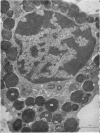Abstract
The Harderian gland of the female golden hamster contains an average of forty times more mast cells in the interstitial tissue than the male gland. A similar sex difference occurs in the connective tissue capsule of the gland. Mast cell numbers in the male Harderian gland increase greatly between two and five months after castration, reaching levels comparable to those found in the female. This postcastrational rise in mast cell numbers is prevented by androgen administration; furthermore, if mast cell numbers are allowed to increase in castrates, subsequent androgen administration will reverse the rise. There is no obvious relationship between mast cell numbers in the Harderian gland of the female hamster and the porphyrin content of the gland.
Full text
PDF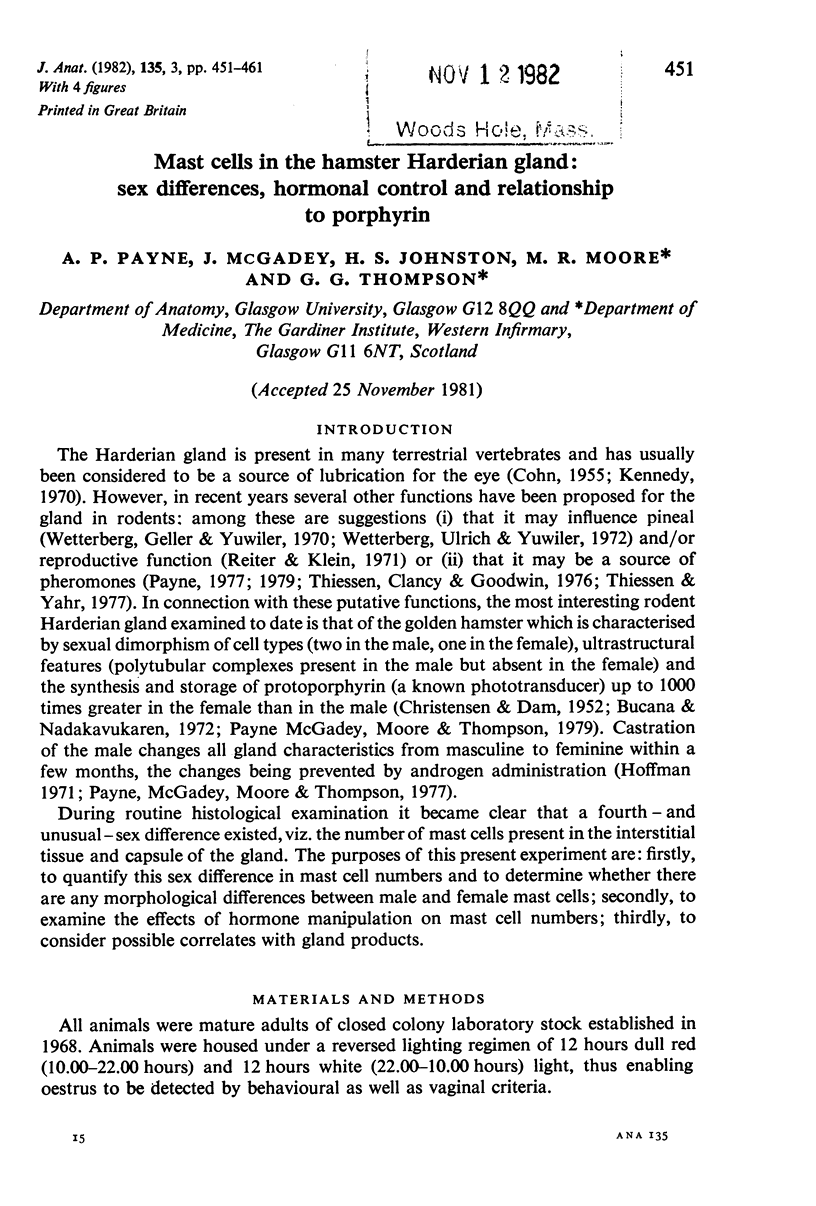
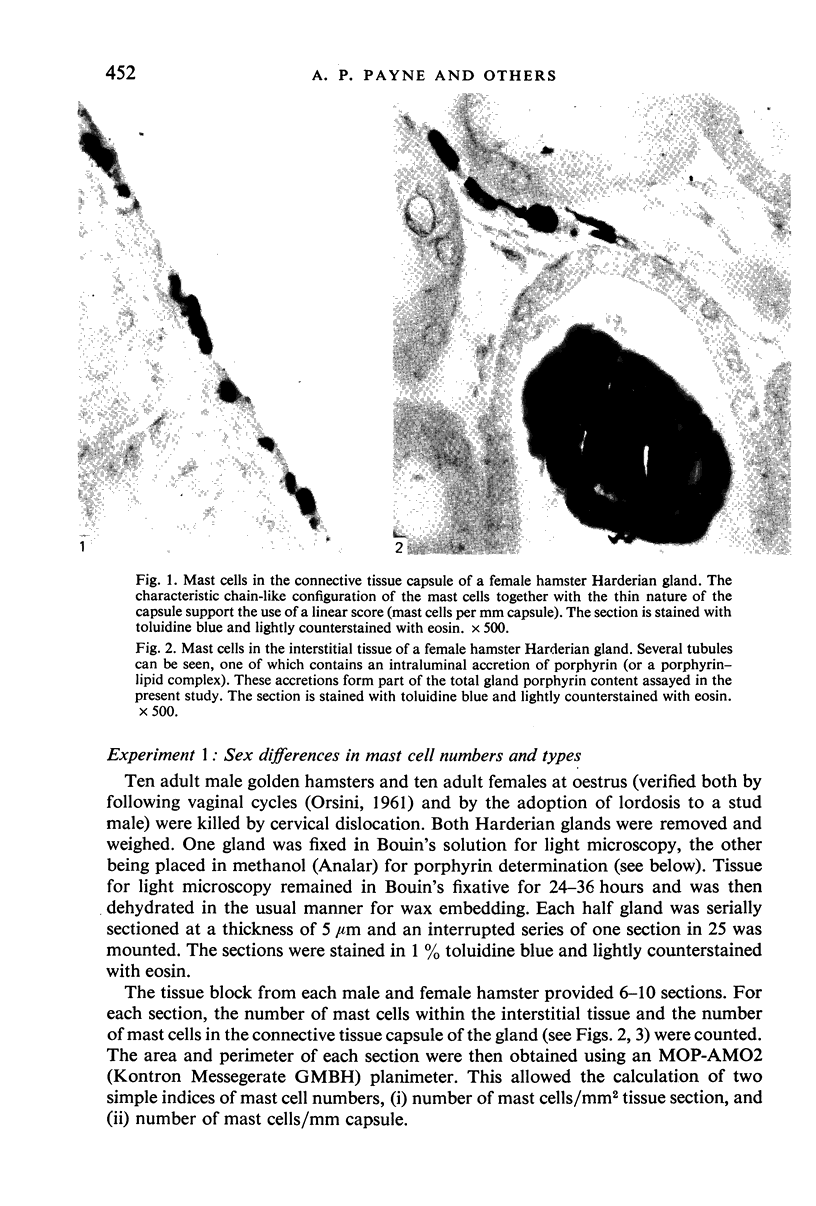




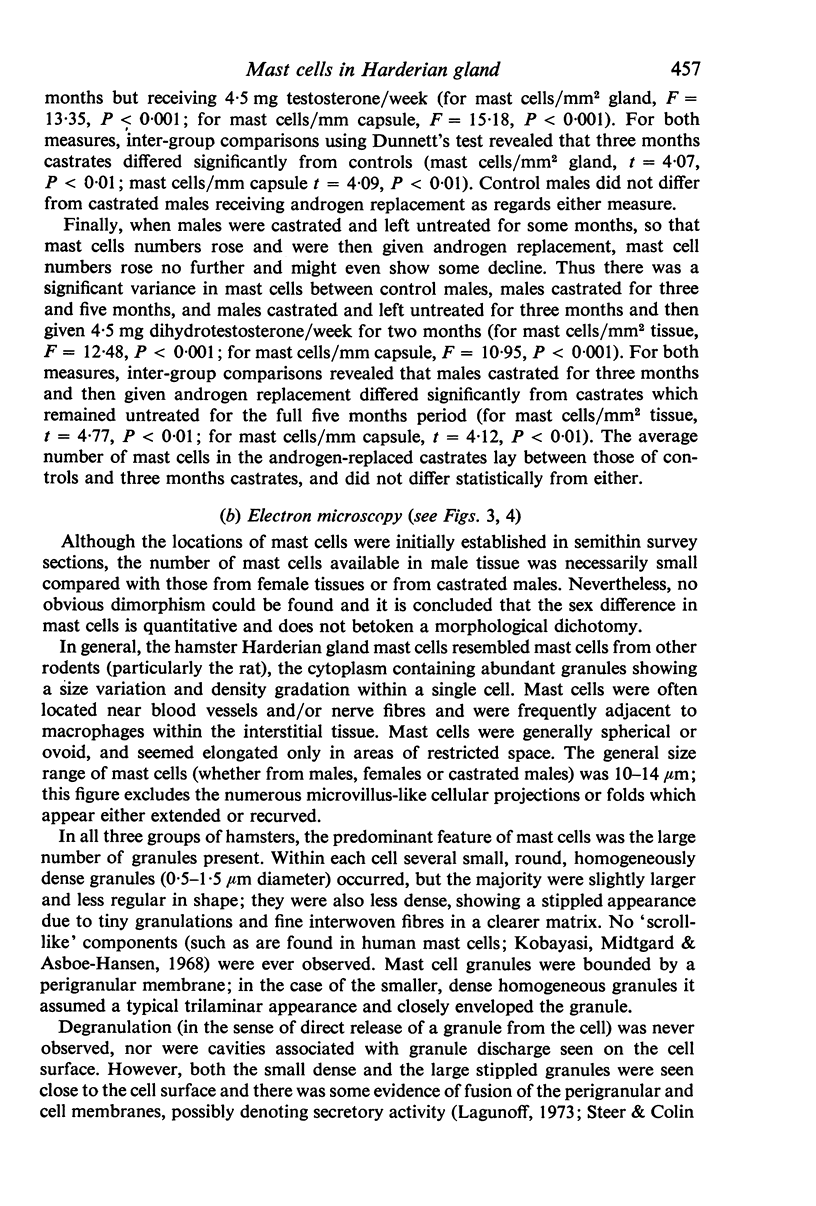
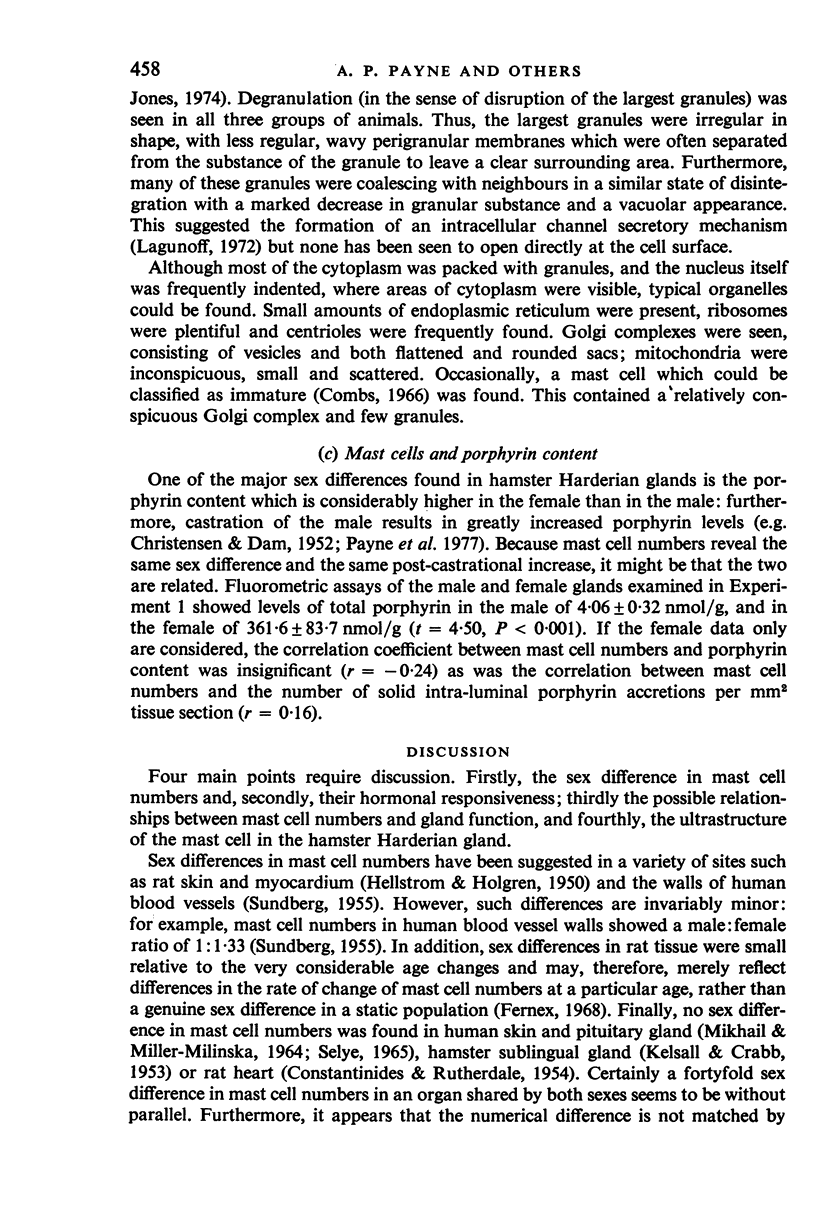



Images in this article
Selected References
These references are in PubMed. This may not be the complete list of references from this article.
- Bucana C. D., Nadakavukaren M. J. Fine structure of the hamster Harderian gland. Z Zellforsch Mikrosk Anat. 1972;129(2):178–187. doi: 10.1007/BF00306934. [DOI] [PubMed] [Google Scholar]
- CHRISTENSEN F., DAM H. A sexual dimorphism of the harderian glands in hamsters. Acta Physiol Scand. 1953 Feb 28;27(4):332–336. doi: 10.1111/j.1748-1716.1953.tb00935.x. [DOI] [PubMed] [Google Scholar]
- COHN S. A. Histochemical observations on the Harderian gland of the albino mouse. J Histochem Cytochem. 1955 Sep;3(5):342–353. doi: 10.1177/3.5.342. [DOI] [PubMed] [Google Scholar]
- Clabough J. W., Norvell J. E. Effects of castration, binding, and the pineal gland on the Harderian glands of the male golden hamster. Neuroendocrinology. 1973;12(6):344–353. doi: 10.1159/000122183. [DOI] [PubMed] [Google Scholar]
- Combs J. W. Maturation of rat mast cells. An electron microscope study. J Cell Biol. 1966 Dec;31(3):563–575. doi: 10.1083/jcb.31.3.563. [DOI] [PMC free article] [PubMed] [Google Scholar]
- Csaba G., Kiss J., Dunay C. Elective localization of 3H-corticosterone in mast cells. Experientia. 1967 Apr 15;23(4):267–269. doi: 10.1007/BF02135676. [DOI] [PubMed] [Google Scholar]
- HARVEY E. B. MAST CELL DISTRIBUTION IN THE UTERUS OF CYCLING AND PREGNANT HAMSTERS. Anat Rec. 1964 Mar;148:507–516. doi: 10.1002/ar.1091480309. [DOI] [PubMed] [Google Scholar]
- HELLSTROM B., HOLMGREN H. Numerical distribution of mast cells in the human skin and heart. Acta Anat (Basel) 1950;10(1-2):81–107. doi: 10.1159/000140456. [DOI] [PubMed] [Google Scholar]
- Hoffman R. A. Influence of some endocrine glands, hormones and blinding on the histology and porphyrins of the Harderian glands of golden hamsters. Am J Anat. 1971 Dec;132(4):463–478. doi: 10.1002/aja.1001320405. [DOI] [PubMed] [Google Scholar]
- Jost U. 1-alkyl-2,3-diacyl-sn-glycerol, the major lipid in the Harderian gland of rabbits. Hoppe Seylers Z Physiol Chem. 1974 Apr;355(4):422–426. doi: 10.1515/bchm2.1974.355.1.422. [DOI] [PubMed] [Google Scholar]
- Kennedy G. Y. Harderoporphyrin: a new porphyrin from the Harderian glands of the rat. Comp Biochem Physiol. 1970 Sep 1;36(1):21–36. doi: 10.1016/0010-406x(70)90647-x. [DOI] [PubMed] [Google Scholar]
- Kobayasi T., Midtgård K., Asboe-Hansen G. Ultrastructure of human mast-cell granules. J Ultrastruct Res. 1968 Apr;23(1):153–165. doi: 10.1016/s0022-5320(68)80039-5. [DOI] [PubMed] [Google Scholar]
- LIKAR I. N., LIKAR L. J. ACID MUCOPOLYSACCHARIDES AND MAST CELLS IN THE BOVINE UTERUS AT DIFFERENT STAGES OF THE SEXUAL CYCLE. Acta Endocrinol (Copenh) 1964 Jul;46:493–506. doi: 10.1530/acta.0.0460493. [DOI] [PubMed] [Google Scholar]
- Lagunoff D. Contributions of electron microscopy to the study of mast cells. J Invest Dermatol. 1972 May;58(5):296–311. doi: 10.1111/1523-1747.ep12540314. [DOI] [PubMed] [Google Scholar]
- Lagunoff D. Membrane fusion during mast cell secretion. J Cell Biol. 1973 Apr;57(1):252–259. doi: 10.1083/jcb.57.1.252. [DOI] [PMC free article] [PubMed] [Google Scholar]
- MESSERSCHMITT J. La mastocytose médullaire dans les hémorragies répétées. Sang. 1955;26(2):252–260. [PubMed] [Google Scholar]
- MIKHAIL G. R., MILLER-MILINSKA A. MAST CELL POPULATION IN HUMAN SKIN. J Invest Dermatol. 1964 Oct;43:249–254. [PubMed] [Google Scholar]
- Moore M. R., Thompson G. G., Payne A. P., McGadey J. Seasonal variation in delta-aminolaevulinate synthase and porphyrin content in the Harderian gland of the female golden hamster (Mesocricetus auratus). Int J Biochem. 1980;12(3):501–504. doi: 10.1016/0020-711x(80)90137-8. [DOI] [PubMed] [Google Scholar]
- Payne A. P., McGadey J., Moore M. H., Thompson G. G. Changes in Harderian gland activity in the female golden hamster during the oestrous cycle, pregnancy and lactation. Biochem J. 1979 Mar 15;178(3):597–604. doi: 10.1042/bj1780597. [DOI] [PMC free article] [PubMed] [Google Scholar]
- Payne A. P., McGadey J., Moore M. R., Thompson G. Androgenic control of the harderian gland in the male golden hamster. J Endocrinol. 1977 Oct;75(1):73–82. doi: 10.1677/joe.0.0750073. [DOI] [PubMed] [Google Scholar]
- Payne A. P. Pheromonal effects of Harderian gland homogenates on aggressive behaviour in the hamster. J Endocrinol. 1977 Apr;73(1):191–192. doi: 10.1677/joe.0.0730191. [DOI] [PubMed] [Google Scholar]
- Payne A. P. The attractiveness of Harderian gland smears to sexually naive and experienced male golden hamsters. Anim Behav. 1979 Aug;27(Pt 3):897–904. doi: 10.1016/0003-3472(79)90027-7. [DOI] [PubMed] [Google Scholar]
- REYNOLDS E. S. The use of lead citrate at high pH as an electron-opaque stain in electron microscopy. J Cell Biol. 1963 Apr;17:208–212. doi: 10.1083/jcb.17.1.208. [DOI] [PMC free article] [PubMed] [Google Scholar]
- Reiter R. J., Klein D. C. Observations on the pineal gland, the Harderian glands, the retina, and the reproductive organs of adult female rats exposed to continuous light. J Endocrinol. 1971 Sep;51(1):117–125. doi: 10.1677/joe.0.0510117. [DOI] [PubMed] [Google Scholar]
- SMITH D. E. THE TISSUE MAST CELL. Int Rev Cytol. 1963;14:327–386. doi: 10.1016/s0074-7696(08)60027-3. [DOI] [PubMed] [Google Scholar]
- Steer H. W., Colin-Jones D. G. Proceedings: Human mast cell degranulation and vacuolation. J Anat. 1974 Nov;118(Pt 2):369–369. [PubMed] [Google Scholar]
- TINEL J., VIMEUX J. Les mastocytes dans les organes de la reproduction. C R Seances Soc Biol Fil. 1952 Dec;146(23-24):1915–1918. [PubMed] [Google Scholar]
- Wetterberg L., Geller E., Yuwiler A. Harderian gland: an extraretinal photoreceptor influencing the pineal gland in neonatal rats? Science. 1970 Feb 6;167(3919):884–885. doi: 10.1126/science.167.3919.884. [DOI] [PubMed] [Google Scholar]





